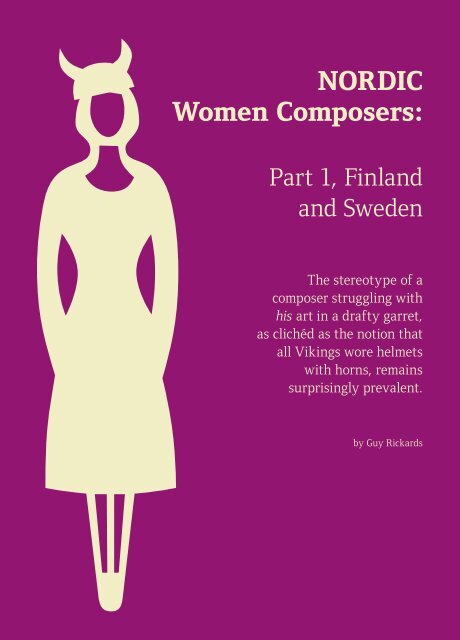No 1–2006 - Karin Rehnqvist
No 1–2006 - Karin Rehnqvist
No 1–2006 - Karin Rehnqvist
You also want an ePaper? Increase the reach of your titles
YUMPU automatically turns print PDFs into web optimized ePapers that Google loves.
NORDIC<br />
Women Composers:<br />
Part 1, Finland<br />
and Sweden<br />
The stereotype of a<br />
composer struggling with<br />
his art in a drafty garret,<br />
as clichéd as the notion that<br />
all Vikings wore helmets<br />
with horns, remains<br />
surprisingly prevalent.<br />
by Guy Rickards<br />
Modern-day Clara Schumanns no<br />
longer give up composing to tend to<br />
greater husbands and have babies.<br />
The Irish-born Elizabeth Maconchy<br />
was one of many to mix careers and<br />
her daughter Nicola Lefanu is also a highly respected<br />
composer. In fact, hundreds of women are successfully<br />
writing music all over the world. In Finland, the<br />
dominant figure is Kaija Saariaho (b 1951) who has<br />
– alone of any of the composers I will be discussing<br />
– achieved major international standing. As she has<br />
deservedly received much attention, I will concentrate<br />
on others less well-known, omitting expatriates like<br />
Paolo Livorsi and Victoria Borisova-Ollas.<br />
If Saariaho is undeniably one of the most respected<br />
living composers of either sex, she was not the first<br />
female one to have emerged in Finland. HELVI<br />
LEIVISKÄ (1902-82) – whose music is well overdue<br />
for revival – emerged in the 1920s, primarily with<br />
chamber and instrumental works, not least her Piano<br />
Concerto, about which one critic wrote that her “serious<br />
artistic approach, perhaps closest akin to that of<br />
Brahms and Bruckner, is here manifest in an already<br />
notably mature and technically lucid idiom.”<br />
The appearance of her Violin Sonata in 1945 cemented<br />
her reputation further, but it was with her three symphonies<br />
and the single-span Sinfonia brevis that she<br />
emerged as a composer of real stature. These charted<br />
a move from late Romanticism through Neoclassicism<br />
to a decidedly modern, but tonal language in her later<br />
works. The splendid Third Symphony, perhaps her<br />
masterpiece, deserves to be far more widely known.<br />
That none are available on disc, when so much mediocrity<br />
is, is little short of scandalous.<br />
LEIVISKÄ, Principal works:<br />
Orchestral:<br />
3 Symphonies (B flat, 1947; D minor,<br />
1954; 1971)<br />
Sinfonia brevis (1962 rev 1972)<br />
Piano Concerto in D minor (1935)<br />
Triple Fugue (1935)<br />
Chamber:<br />
Piano Quartet (1926-35)<br />
Piano Sonatina in F major (1935)<br />
Violin Sonata in G minor (1945)<br />
Suite antique for piano (1929)<br />
Both Pauliina Isomäki (b 1964) and jazz pianist<br />
Anna-Mari Kähärä (b 1963) have followed different<br />
paths. Kähärä founded the vocal ensemble How Many<br />
Sisters and has worked with Karl Jenkins and Adiemus,<br />
the crossover ensemble Zetaboo and violinist Pekka<br />
Kuusisto. Jazz is her main interest, for which she has<br />
won high recognition (she won the Yrjö prize of the<br />
Finnish Jazz Federation and the Suomi Art Prize in<br />
2002). Her debut album, Anna-Mari Kähärä Orchestra,<br />
was released by EMI Finland in 2005. Although<br />
Isomäki studied in the USA (Catawba College) and<br />
piano at Åbo Academy, she later took up the recorder<br />
as performer and teacher. She has composed music in<br />
many genres, from stage works to recorder solos.<br />
RIIKKA TALVITIE (b. 1970) has found success as<br />
oboist and composer, not unlike Melinda Maxwell in<br />
Britain. As oboist, she has premiered many new works<br />
and helped found the Uusinta Chamber Orchestra. Like<br />
Saariaho she studied with Heininen at the Sibelius<br />
Academy and later with Leroux at IRCAM, and Grisey<br />
at the Paris Conservatoire.<br />
She has written much for the voice, with solo and part<br />
songs, motets and a small comic opera, Maestro vie.<br />
In 2001 her choral works Kuvan kuva (The image of<br />
an image) and Ihmisen määvä (Measure for Man) took<br />
1 st and 3 rd Prizes at Tampere’s Vocal Music Festival.<br />
Tulen värinä (The Flicker of Fire, 2002) is also fine, a<br />
serious-minded, compact cantata for tenor, 3 soli and<br />
male choir setting Mikko Rimminen’s apocalyptic<br />
poem. The music shows her flair for texture and colour,<br />
not least in handling the text’s word games and<br />
wry humour. For her own instrument she has written<br />
the vivacious 5-minute Perspectives and a concerto<br />
Tululuikku – one of her largest works. Microintervals<br />
and multiphonics feature as does, in the concerto, the<br />
luminous orchestration evident in much of her work.<br />
(In 2000, her first orchestral work Keppihevostellen<br />
– ‘Hobby-horsing around’ for strings – won 3 rd Prize<br />
in the Kuopio Composition Competition.) Kivi, sakset,<br />
paper takes the famous children’s game Rock, Paper,<br />
Scissors as starting point, moving “smoothly towards<br />
a toccata – an oompah effect. Since the game did not<br />
provide any example of how to end the piece, I decided<br />
to cut the oompah band off short...”<br />
Following her IRCAM period Talvitie has used electronics<br />
in her works, sometimes as noise effects for expressive<br />
impact. Works like Luonnonoikku for violin &<br />
electronics (2002) and Matches for piano & tape (2004)<br />
should be seen in light of her interest in unusual duos<br />
and trios, evidenced lately by Bit by Bit for clarinet,<br />
accordion and cello, Veden huoneet for 2 organs and<br />
Beyond the web for guitar & cello.<br />
4 5


